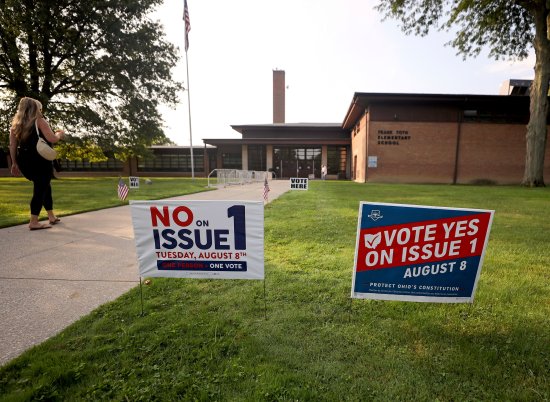
"On the Republican side there are probably going to be autopsies of just how badly Issue 1 was handled."
After Ohio voters rejected an effort to make it harder to change the constitution before a vote on an abortion-rights ballot initiative, Republicans elsewhere may take lessons from the failure as they try to restrict abortion in their own states.
“On the Republican side there are probably going to be autopsies of just how badly Issue 1 was handled,” says Mary Ruth Ziegler, law professor at UC Davis.
Ohio’s Issue 1, which was defeated on Tuesday, would have raised the threshold to pass a ballot initiative from a simple majority to 60%. As red states have enacted abortion bans after the fall of Roe v. Wade, Democrats have increasingly turned to ballot initiatives to preserve access— and in turn, Republicans have started trying to make it more difficult to pass those amendments.
[time-brightcove not-tgx=”true”]Ohio proved again that messaging about abortion on ballot initiative matters may motivate the left more than the right in a post-Roe country. While Ohio’s Issue 1 wasn’t directly about abortion, activists on both sides set the fall vote on the abortion ballot initiative as the most immediate stakes of the issue.“The abortion-related aspects of this certainly motivated many Ohio voters to turn out and vote in what otherwise might have been a sleepy August election,” says Rick Hasen, a UCLA law professor and election expert.
Read More: Don’t Look Now, But Ohio Might Be a Swing State Again
Some Ohio Republicans shied away from that reasoning and emphasized the need to raise the threshold in order to minimize the influence of special interests in politics—a rationale that Republicans in other states may be more likely to promote in the future.”It wouldn’t surprise me if you saw another state look at this and say, you know, we’re actually going to try to make this as dry and boring and unrelated to abortion as we humanly can,” says Ziegler.
When abortion is on the ballot, voters since the Dobbs v. Jackson Women’s Health Organization Supreme Court decision overturned Roe have resoundingly voted to support abortion rights. Six states had abortion-related measures on the ballot in 2022; all six were victories for abortion-rights advocates, including those in more conservative states such as Kansas and Kentucky.
Missouri Republicans also tried and failed this year to make it harder to pass a ballot initiative. Missouri State Rep. Mike Henderson believes the failures in his state and Ohio should be instructive on how to craft these proposals. Instead of Ohio’s proposed 60% vote threshold, he wanted the bar to be closer to 55%; eventually, the Missouri legislation landed on 57%. “60% in Missouri cannot pass. We’ve done polling; we know that people think that’s too high a threshold,” Henderson says.
Henderson has also landed on the messaging strategy: he notes that his effort pre-dates the Dobbs decision and says it isn’t about abortion alone. “Has that become a part of the equation? Certainly it has. But I don’t think that in itself was the only thing,” he says.
Moreover, trying to get voters to diminish their own political influence—which is effectively what proposals to make it tougher to pass ballot initiatives would accomplish—is a hard sell. The Associated Press wrote that the size of the vote lead in Ohio “indicates that a sizable number of Republicans voted against” Issue 1, despite it being a Republican-led effort. “Voters don’t like to have their voting rights taken away,” says Hasen. “The process of direct democracy is generally popular with voters… It’s not surprising that on a bipartisan basis, voters were not willing to give up their own power.”
There is a long history of both parties attempting to restrict the ballot initiative process. But recent years have changed the political dynamics. A study published earlier this month that looked at constitutional amendments to restrict the ballot initiative process from 1960-2022 found that the number of amendments restricting direct democracy has not been unusually high recently. (The actual peak is around 1995-2005.) It is, however, more partisan. “It’s very clear that Republicans are more likely to do this than Democrats, especially in the last 20 years,” says John G. Matsusaka, the study’s author and a professor of business and law at University of Southern California. Another analysis published on Democracy Docket found a similar trend.
That partisanship trend is likely going to continue as Democrats around the country focus on ballot initiatives as a mechanism to protect abortion. The next major fight may be in Arizona, where abortion-rights advocates announced Tuesday that they began an attempt put abortion on the state’s ballot in 2024. Progressives are already worried about Issue-1 style restrictions: “Legislators in Arizona will try to make the process harder,” says Hannah Ledford, deputy executive director and campaigns director at The Fairness Project, a left-leaning advocacy group. “No question.”